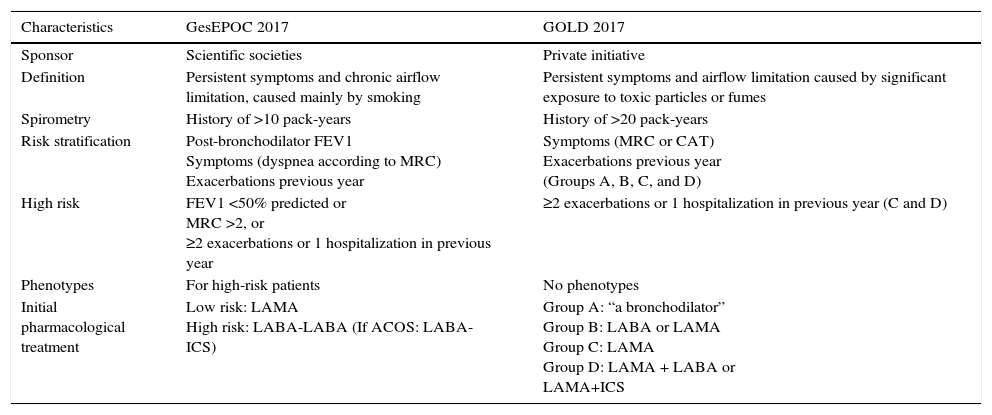The GesEPOC Spanish COPD guidelines first appeared in 2012,1 and were subsequently updated in 2014. For the first time in the international medical literature, a different approach was proposed for the classification of clinical phenotypes and corresponding treatment strategies. This clinical practice guideline stratified disease severity from a multidimensional standpoint, taking into account symptom intensity, risk of exacerbations, lung function involvement, and the use of multidimensional indices such as BODE or BODEx.
One year earlier, in 2011, the Global Initiative for Chronic Obstructive Lung Disease (GOLD) published an update containing new recommendations.2 In this update, the approach to the disease changed substantially, switching from disease management focused uniquely on FEV1, to a multidimensional strategy based on bronchial obstruction, symptoms, and risk of exacerbations. This reflected an acceptance of the new mindset proposed by the BODE group, which aimed to reverse the old nihilism surrounding COPD: patients are more than just subjects with gradually deteriorating, irreversible FEV1. Other factors such as dyspnea, exercise capacity, and nutritional status determine prognosis and can be modified with treatment.3,4 This year, 2017, has seen the publication of new updates of both GesEPOC and GOLD, both of which adopt a multidimensional perspective to some extent or other. Our aim in this short editorial is to discuss the differences in these guidelines, as summarized in Table 1.
Differences between GesEPOC and GOLD in 2017.
| Characteristics | GesEPOC 2017 | GOLD 2017 |
|---|---|---|
| Sponsor | Scientific societies | Private initiative |
| Definition | Persistent symptoms and chronic airflow limitation, caused mainly by smoking | Persistent symptoms and airflow limitation caused by significant exposure to toxic particles or fumes |
| Spirometry | History of >10 pack-years | History of >20 pack-years |
| Risk stratification | Post-bronchodilator FEV1 Symptoms (dyspnea according to MRC) Exacerbations previous year | Symptoms (MRC or CAT) Exacerbations previous year (Groups A, B, C, and D) |
| High risk | FEV1 <50% predicted or MRC >2, or ≥2 exacerbations or 1 hospitalization in previous year | ≥2 exacerbations or 1 hospitalization in previous year (C and D) |
| Phenotypes | For high-risk patients | No phenotypes |
| Initial pharmacological treatment | Low risk: LAMA High risk: LABA-LABA (If ACOS: LABA-ICS) | Group A: “a bronchodilator” Group B: LABA or LAMA Group C: LAMA Group D: LAMA + LABA or LAMA+ICS |
Abbreviations: ACOS: asthma-COPD overlap syndrome; CAT: COPD Assessment Test scale; FEV1: forced expiratory volume in 1 second on post-bronchodilator spirometry; ICS: inhaled corticosteroids; LABA: long-acting beta-adrenergic bronchodilator; LAMA: long-acting antimuscarinic bronchodilator; MRC: Medical Research Council dyspnea scale.
GesEPOC is a clinical practice guideline sponsored by scientific societies (primarily SEPAR), while GOLD is the work of a team of independent experts. The two documents are distinct types: GesEPOC is a clinical practice guideline that combines recommendations based on Grade of Recommendations Assessment, Development and Evaluation (GRADE) methodology with the opinion of experts in aspects where the GRADE methodology is not applicable; GOLD is a strategic document based on expert opinion after a systematic literature review.
There are no essential differences in the concept of diagnosis, except with regard to the cutoff points for recommending spirometry in former and active smokers: 10 pack-years in GesEPOC and 20 pack-years in GOLD.
Both proposals embrace a similar concept of COPD as a multidimensional disease, but post-diagnosis therapeutic approaches diverge. GesEPOC uses three dimensions to determine risk: lung function, symptoms, and exacerbations in the previous year. The concept of risk refers to the probability of future exacerbations, disease progression, complications, use of health resources, and death. Risk is categorized as low or high. GOLD now uses the conventional definition of grades of obstruction for prognostic purposes only, and includes only a two-dimensional assessment (symptoms and history of exacerbations) to guide treatment. Both documents use similar cutoff points for exacerbations, but GesEPOC bases its classification on MRC scale symptoms, while GOLD still uses the COPD Assessment Test (CAT).
In the updated GesEPOC, clinical phenotype is now determined in high-risk patients only.5 This simplifies patient evaluation: treatment of low-risk patients is based on bronchodilation, while a more personalized intervention is recommended in high-risk patients. The new update of the GOLD recommendations6 has removed the term “inflammation” from its definition, thus reducing the importance of inhaled corticosteroids (ICS), and placing more emphasis on bronchodilators. The conventional classification of severity grades is maintained only for prognostic purposes, but not for guiding treatment.
The main difference between these documents still lies in use of drugs, which paradoxically is based on the same evidence. GesEPOC has simplified treatment by stratifying risk. The therapeutic scheme places more importance on LAMAs and dual bronchodilation in low-risk patients. In high-risk patients more importance is given to dual bronchodilation, with ICS as first-choice therapy only in the asthma-COPD overlap syndrome (ACOS) phenotype, and as a second-choice after bronchodilation in frequent exacerbators. The GOLD therapeutic recommendations are two-dimensional, focusing on symptoms and previous history of exacerbations. Bronchodilators form the therapeutic backbone, with the possible use of either LAMA or LABA, but more probably a combination of the two, while ICS are reserved for group C or D exacerbators, and always in combination with LABA or LAMA.
Despite the difficulties in reaching a robust definition of the ACOS phenotype, this concept is recognized in GesEPOC and treatment recommendations are given, while in GOLD it is only mentioned.
In summary, it seems that, echoing the old slogan “Spain is different”, the GesEPOC approach, while based on the same evidence, is new and different. Although robust evidence is needed to support this new version of the guidelines, there is little doubt that that it is fresh and innovative, and will generate constructive discussions on the different fora.
Please cite this article as: de Torres JP, Marin JM. Diferencias entre GesEPOC y GOLD en el año 2017. Arch Bronconeumol. 2017;53:295–296.










